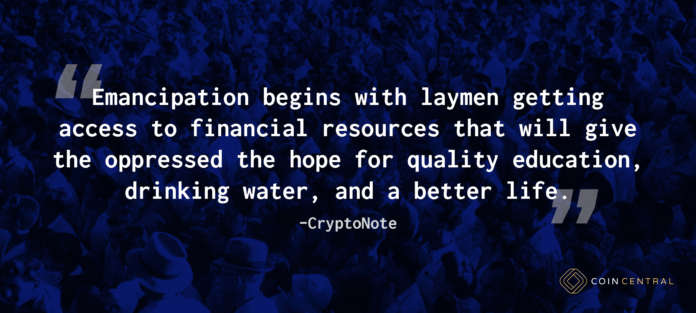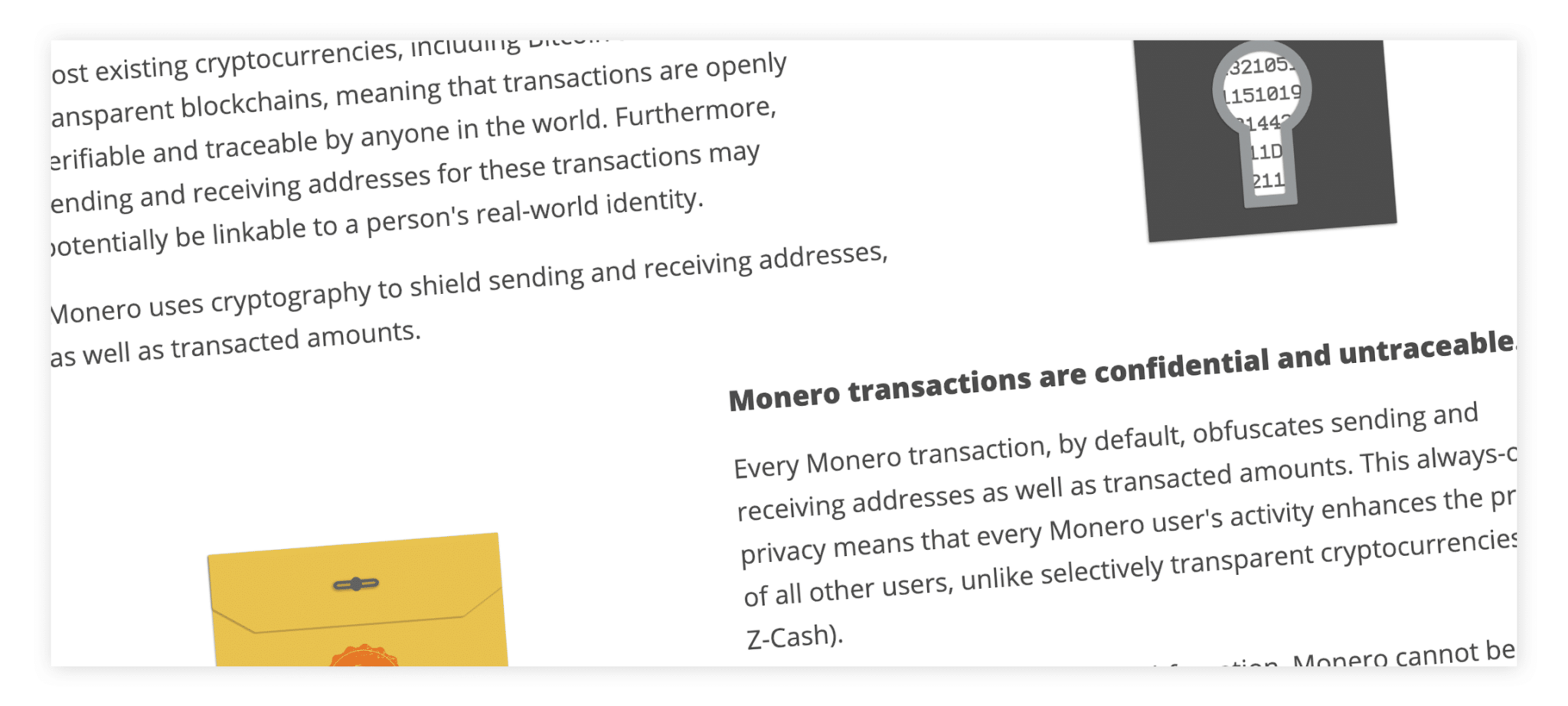
Understanding the CryptoNight algorithm requires us to first visit what the technology CryptoNote is all about.
CryptoNote is as much a software stack as it is a philosophy. As described on the CryptoNote website, “CryptoNote is the technology that allows the creation of completely anonymous egalitarian cryptocurrencies.”
The description further expands on their philosophy with disdain for the current power distribution currently “…making human beings engage in rat races, detrimental rivalry and bloodshed.”
In many ways, CryptoNote is a means to an end. The creators of CryptoNote see the technological breakthrough of the blockchain as a human empowering tool. A mechanism to control transparency, eliminate the power imbalance, and reestablish personal sovereignty.
Best said by the creators of CryptoNote: “CryptoNote is not about creating yet another digital currency. It is the mindset and concepts that represent the first small step to regain the power over ourselves in order to live peacefully and prosper.”
CryptoNote or CryptoNight?
Both! In simple terms, CryptoNote is the umbrella technology that focuses on two primary concerns: untraceable payments and unlinkable transactions.
CryptoNight is the hashing algorithm that CryptoNote projects can use.
Let’s explore the two in more depth.
CryptoNote: The Anonymous Egalitarian Cryptocurrency Platform
CryptoNote – not a cryptocurrency, mostly.
Technically CryptoNote does have a coin, aptly named the CryptoNoteCoin. However, do not trade this coin… seriously, don’t. The CryptoNoteCoin is entirely for research and educational purposes. In fact, the coin is deliberately debased every two months by recreating the genesis block.
Despite not being a cryptocurrency itself, think of CryptoNote as a platform for anonymous and egalitarian cryptocurrencies.
Egalitarian motives are baked into the philosophy of CryptoNote.
Anonymous by Default
CryptoNote focuses on two primary avenues to maximize anonymity at the protocol level: untraceability and unlinkability.
To be untraceable, CryptoNote leverages ring signatures to obfuscate the private and public keys in a transaction.
Simply put, your public key is in a group with other public keys so that analysis of your transaction cannot reveal you specifically. Rather, tracking your transaction will point to the group of public keys you belong to, not your specific address.
However, in the case of ring signatures, if your public keys are known then a reverse analysis is possible. In this case, analysis begins with your known public keys. Someone could then follow the transaction pathways to better understand the transaction.
To avoid this linking of your public keys to the activities of a transaction, CryptoNote employs one-time keys. Essentially, public addresses generate on a per use basis. This makes any reverse analysis highly improbable if not near impossible.
Egalitarian by Choice
Cryptocurrencies for the people! In a nutshell, egalitarianism is a political philosophy that emphasizes the equality of all constituents. According to the Stanford Encyclopedia of Philosophy, “People should be treated as equals, should treat one another as equals, should relate as equals or enjoy an equality of social status of some sort.”
In terms of CryptoNote, the tokenomics and governance of any blockchain using CryptoNote are egalitarian by default. Most notably in the mining of CryptoNote blockchains.
Blockchain security and validation, more commonly known as mining, often are victims of their own success. This is primarily due to the advent of ASIC (application-specific integrated circuit) mining.
A typical growth pattern of a blockchain will initially involve CPU and GPU miners. This type of mining equipment is fairly accessible to the general public and can be relatively affordable. The challenge comes when a blockchain becomes increasingly profitable for miners and inevitably attracts more competitive sources of capital.
Enter the ASIC. A specialized miner can be tenfold more powerful and efficient when mining. However, the development of specialized chips are prohibitively expensive and as such skew the centralization of mining.
Blockchain environments that are ASIC friendly often see extensive centralization of their hashing power into these specialized mining operations. Look no further than the bitcoin mining behemoth Bitmain, which has been successfully developing and operating their line of ASIC miners, including the famed Antminer.
To resist specialized mining, CryptoNote leans on two principles: requiring access to memory and being latency dependent. Without getting into the weeds on these, just know that these principles target the ASIC equipment by slowing down their ability to solve the required equations necessary to secure a blockchain and reap the block rewards.
Backstory of CryptoNote
The storied background of CryptoNote is definitely worth learning about. It’s an interesting labyrinth with possible ties to the Standford Bitcoin Group, Nick Szabo, and Satoshi Nakamoto to name a few.
For example, officially, Nicolas van Saberhagen is accredited in the white paper as the creator of CryptoNote. However, the identity of Saberhagen is unknown despite having once agreed to an in-person speech at a conference workshop. Saberhagen did not show and instead opted to call in via Skype with a voice anonymizer.

The CryptoNote white paper by Nicolas van Saberhagen
CryptoNight: The Proof-of-Work Equalizing Algorithm
Now that you know that CryptoNote is a platform for launching privacy-focused, egalitarian blockchains, let’s focus on the more widely known component: CryptoNight.
CryptoNight is a proof-of-work hashing algorithm at the heart of the CryptoNote platform. This is where the egalitarian equalization really proves itself within CryptoNote.
As mentioned, CryptoNote limits the capabilities of specialized miners by being memory intensive. This is why CryptoNight is a memory-hard hashing algorithm.
In addition to being memory-hard, CryptoNight further dissuades the adoption of ASIC miners by being latency dependent. This refers to the time it takes for the mining hardware to solve an equation. For example, when computing an equation of 10+10, a preset latency will delay the results of 20.
The latency actively levels the playing field between various mining hardware. Furthermore, the computational calculations force a dependency on the calculation prior. This means that mining hardware cannot continue onto the next problem while waiting for the current equation to be returned.
CryptoNight in the Wild
It can be difficult parsing out the origins of CryptoNight and the various key players. Most accounts of the development of CryptoNight point to two entities: CryptoNote and Bytecoin.
It is likely that the Bytecoin team is at least partially comprised of CryptoNote developers, but that division is tough to determine. For the most part, Bytecoin is seen to be among the first cryptocurrencies to use the CryptoNote protocol and test out CryptoNight beyond the educational CryptoNoteCoin.
There are indications that the Bytecoin was initially incubated within the CryptoNote team, after which they separated from the core developers of CryptoNote. The CryptoNote team did, however, return to promote and develop Bytecoin in some capacity.
The exact details are difficult to ascertain as nearly every person in CryptoNote and Bytecoin is anonymous. It’s possible these two teams are one and the same but impossible to determine with full accuracy.
The Monero Factor
Today, Bytecoin is mostly a dead coin. The ASIC miners were able to overtake the hashing power of Bytecoin and dramatically shift the market.
But wait, I thought CryptoNote is ASIC resistant?
Keyword: resistant. Given enough time and popularity, ASIC manufacturers will crack the code and eventually find their profitability. Even the most ASIC resistant algorithms are subject to this threat.
Bytecoin was unable to keep the ASIC miners at bay because the protocol was left mostly untouched for years. Contrast this to the dynamic and regular updates of Monero, which continues to manage the advent of ASIC miners on their blockchain.

Monero is one of the most popular blockchains to use CryptoNight.
Monero’s most recent fork implemented CryptoNightV8. With this update, any and all active ASICs mining the Monero blockchain were bricked, rendering them useless. Furthermore, Monero reinforced the memory-hard aspect of the CryptoNight algorithm, increasing the required memory.
Monero, currently, is the best use case for CryptoNight, provided the open-sourced developers continue to be true to the egalitarian principles.
Wrapping Up – What is CryptoNight?
As evident from Monero, being an ASIC resistant blockchain is an ongoing and dynamic challenge. CryptoNight is one tool within the CryptoNote protocol that provides a foundation for a blockchain to be egalitarian. However, without care and constant nurturing, CryptoNight is not indefinitely ASIC resistant.
In fact, time and popularity are the most corrosive factors to an ASIC resistant blockchain. Successful CryptoNote blockchains must remain ahead of the hardware manufacturers to be wholly unattractive.
Therefore, CryptoNight driven egalitarianism on a blockchain is an ongoing and active principle, not a static end-point.
The post Unbundling CryptoNight and the Enigmatic CryptoNote appeared first on CoinCentral.

Coincentral.com is author of this content, TheBitcoinNews.com is is not responsible for the content of external sites.
Our Social Networks: Facebook Instagram Pinterest Reddit Telegram Twitter Youtube










